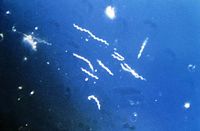Borrelia burgdorferi
| Borrelia burgdorferi |
|---|
| Scientific classification |
|
|
Description and significance
B. burgdorferi is a motile, two-membrane, spiral-shaped bacteria which is found mostly in North America and Europe. It's named after American scientist Willy Burgdorfer, who in 1982 isolated and determined the bacteria to be the causative agent of Lyme disease. Lyme disease is the most common tick borne disease in the US. [1]
Genome structure
B. burgdorferi has a complex genome containing linear DNA, accompanied by up to 20 circular as well as linear plasmids. A study in 1997 found the linear DNA to be composed of 910,725 base pairs (average G+C content of 28.6%), and at least 17 linear and circular plasmids with a combined size of more than 533,000 base pairs.
The chromosomes contains 853 genes encoding a basic set of proteins for DNA replication, transcription, translation, solute transport and energy metabolism, but no genes for cellular biosynthetic reactions. Of 430 genes on 11 plasmids, most have no known biological function.The biological significance of the multiple plasmid-encoded genes is not clear, although they may be involved in antigenic variation or immune evasion.
| Number | Percent | |
|---|---|---|
| Total Number of all DNA molecules: | 18 | 100.00% |
| Total Size of all DNA molecules: | 1443725bp | 100.00% |
| Total number of linear DNA bases: | 910,725bp | 63.1% |
| Number of chromosomal G+C bases: | 256551bp | 28.17% |
| Number | Percent | |
|---|---|---|
| Total genes: | 853 | 100.00% |
| Protein coding genes: | 793 | 93% |
| Genes assigned a role category: | 502 | 59% |
| Genes not assigned a role category: | 51 | 6.26% |
| Hypothetical genes: | 102 | 12% |

